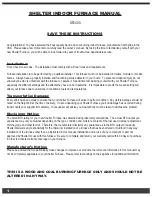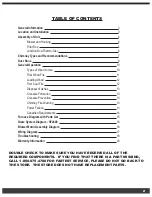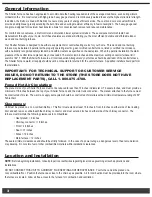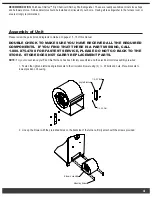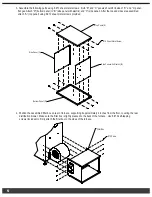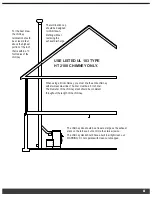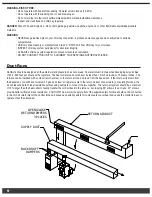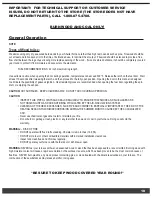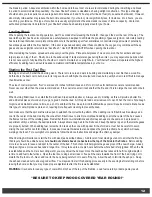
13
NOTE: Do not burn coke, charcoal, highly volatile Bituminous coal, sub Bituminous, lignite or cannel coal (sometimes called channel coal
or candle coal). Never burn chemically processed logs, such as fire logs, as their use is intended for fireplaces only. Please follow all
guidelines in this manual concerning wood and coal burning applications due to safety concerns and to maintain warranty coverage.
BURN WOOD AND COAL ONLY!
Disposal of Ashes:
Heat resistant gloves are recommended, in order to remove ashes from your Shelter Furnace. Remove the ash pan from the furnace
and dump the ashes into a metal container with a tight fitting lid. The closed container of ashes should be placed on a non-combustible
floor or on the ground, well away from all combustible materials, pending final disposal. If the ashes are disposed of by burial in soil or
otherwise locally dispersed, they should be retained in the closed metal container until all cinders have thoroughly cooled.
Remove the ashes from your Shelter Furnace at least once a day, or as often as necessary to ensure the ashes do not accumulate to
the height of the grates. If ash build-up occurs at grate level, it will cause premature failure of the grate system, voiding the warranty on
the grates. Unacceptably high temperatures will result because the ashes have restricted the flow of cooling air beneath the grates. This
flow of air was designed to not only cool the grates, but also to provide warmed air for better combustion. If the ash level is improperly
maintained the firebox will be starved of combustion air, greatly reducing the efficiency and heat output of your Shelter Furnace.
CAUTION: HOT SURFACES. KEEP CHILDREN AWAY. DO NOT TOUCH DURING OPERATION.
IMPORTANT: FOR TECHNICAL SUPPORT OR CUSTOMER SERVICE
ISSUES, DO NOT RETURN TO THE STORE (THE STORE DOES NOT HAVE
REPLACEMENT PARTS), CALL 1-800-875-4788.
Creosote Formation and Need for Removal:
When wood is burned slowly, it produces compounds in exhaust smoke which combine with expelled moisture to form creosote. The
creosote vapors condense in the relatively cooled chimney flue of a slow burning fire. As a result, creosote residue accumulates on the
flue lining. When ignited, this creosote makes an extremely dangerous fire in the chimney. The chimney connector and the chimney
should be inspected at least twice monthly during the heating season to determine if a creosote build-up has occurred. If creosote has
accumulated it should be removed to reduce risk of a chimney fire.
Creosote Prevention:
To help reduce the formation of creosote within the flue, ALWAYS BURN DRY, SEASONED WOOD. Dry wood burns hotter, allowing flue
gases to maintain temperatures above 212°F which should reduce the quantity of creosote in the chimney. If the flue gas temperature
falls below 212°F, condensation occurs causing creosote formation and accumulation within the chimney.
As an added precaution, periodic chimney inspections are recommended during the heating season to determine if creosote formation
has occurred. For safety and efficiency, it is recommended that the chimney system be inspected and cleaned prior to each heating
season.
Chimney Fire Warning:
In the event of a chimney fire, take the following actions immediately:
• Activate and toss a Chimfex™ Dry Chemical Chimney Fire Extinguisher into the firebox.
• Close the ash drawer, fuel door, spin draft and turn the draft control to the lowest setting.
• Alert entire household and prepare to evacuate if necessary.
• Call your local fire department.
Power Failure:
In case of power failure, to prevent your Shelter Furnace from over-heating and causing damage to the electrical components, follow
these steps:
• Close the spin damper control on the ash drawer.
• Turn the draft control to the lowest setting.
• Do NOT add more fuel (coal or wood) to the firebox.
Содержание SF2400
Страница 25: ......


